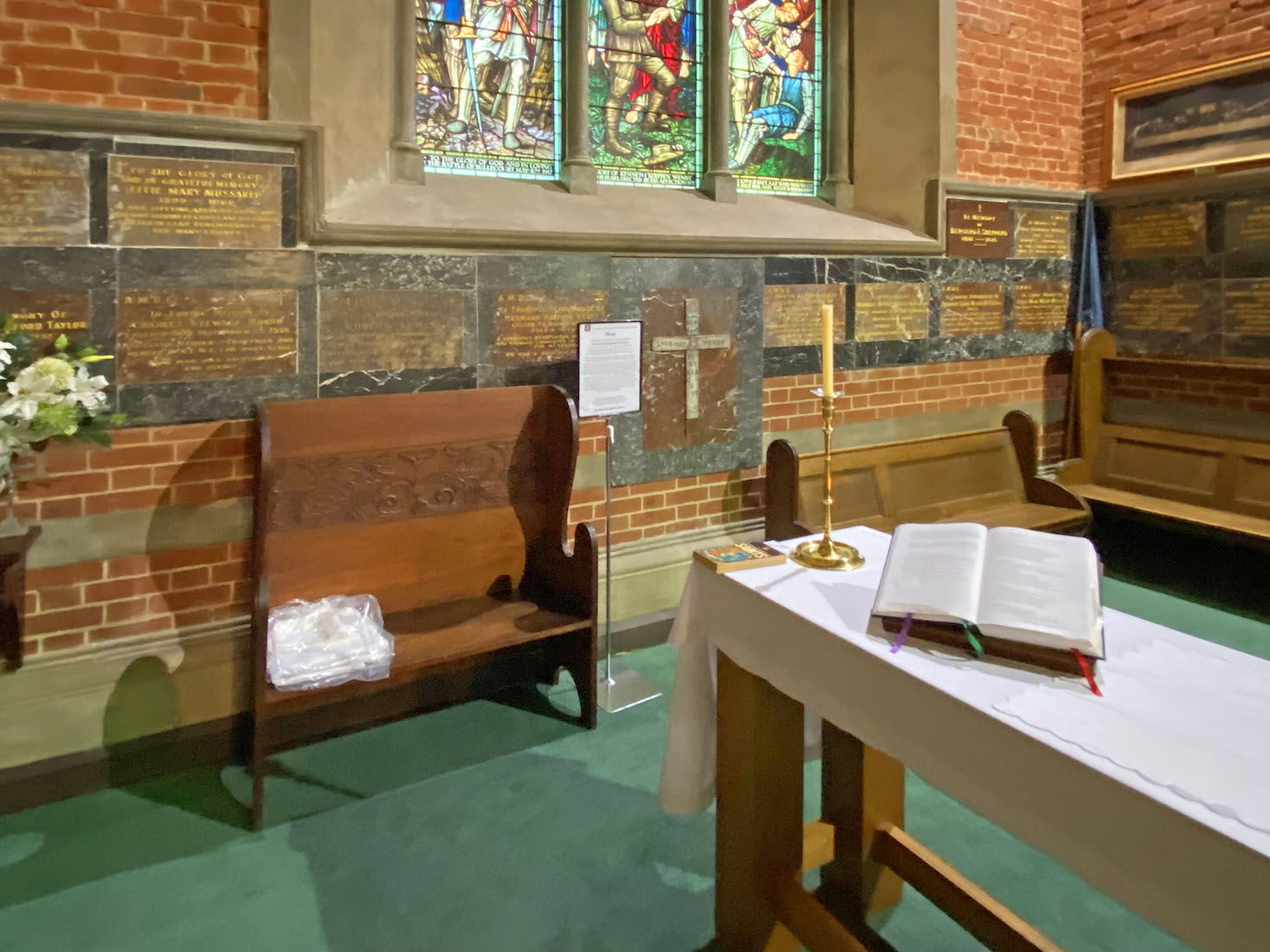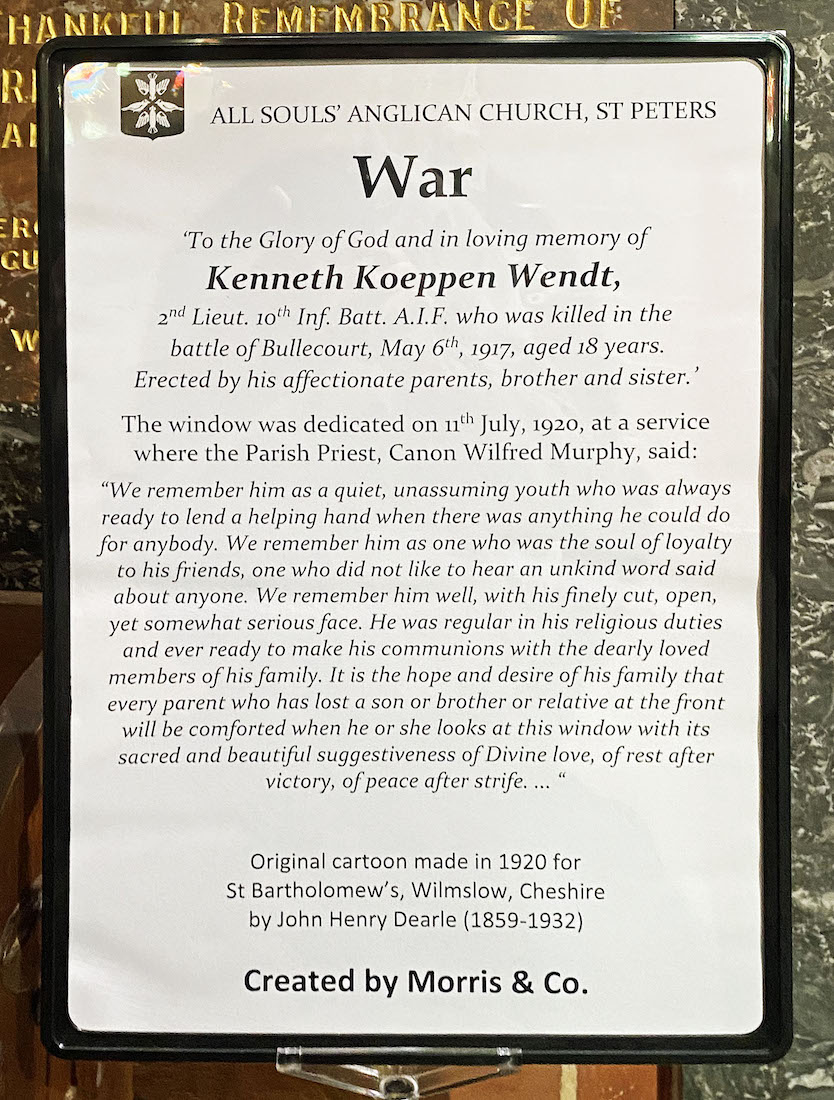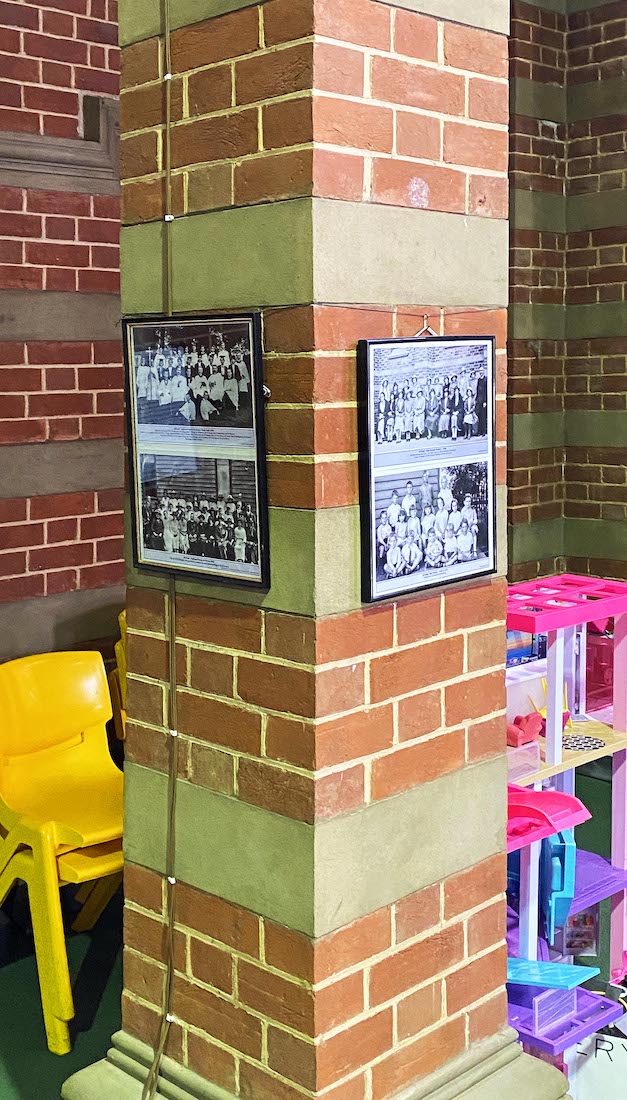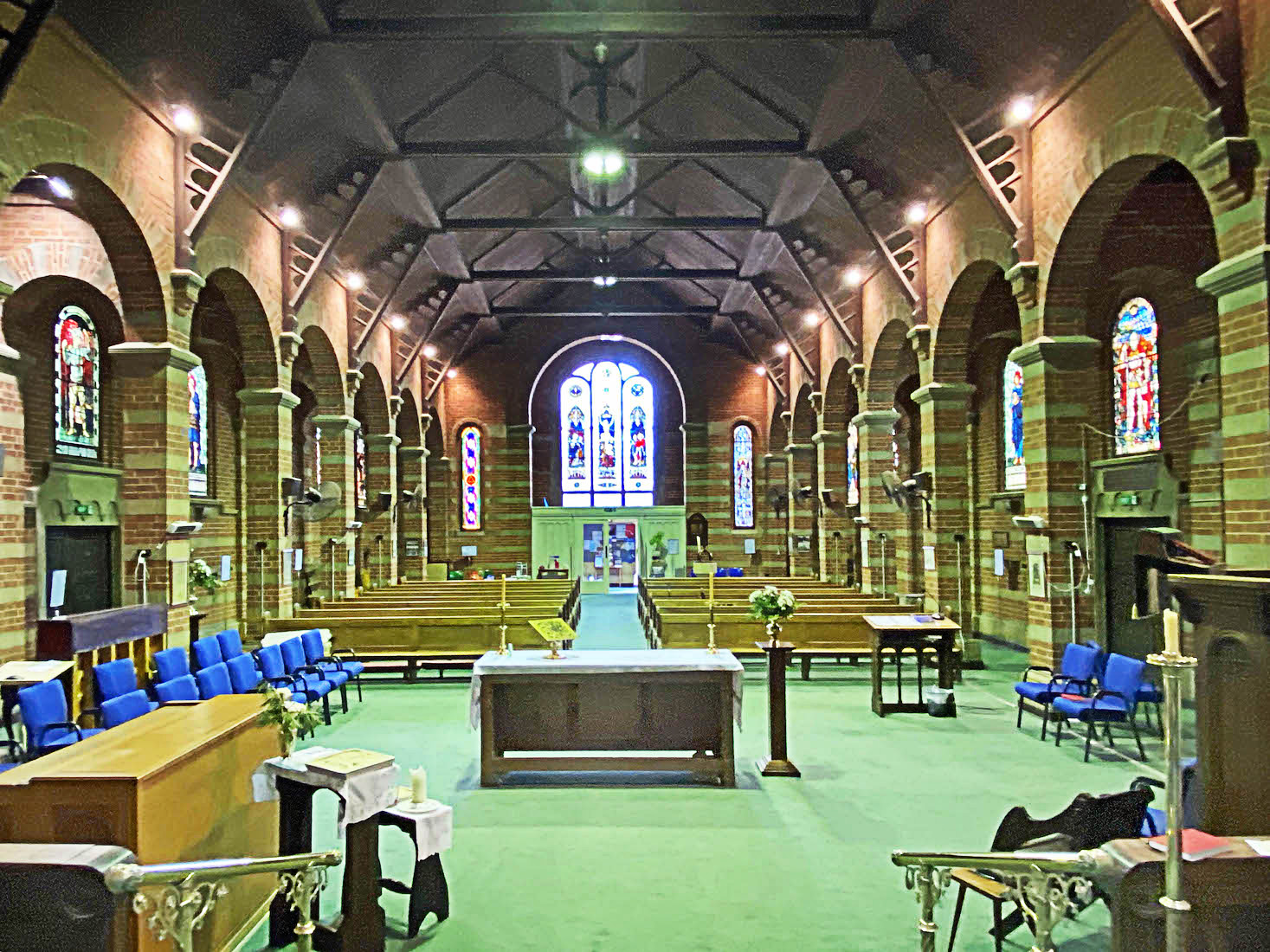59. PHOTO, LIST, INFORMATION SHEETS



We shall find that the young man Kenneth Koeppen Wendt has a prominent role in the setting up of this Chapel. The photo shows him as a young soldier who was killed in action in France in 1917, aged 18 years. The sheets give detailed information about Wendt, and also about the setting up of the Memorial Chapel. You can also read about him here. •• The list of Sidesmen has nothing to do with the Chapel, but is of historical interest. INDEX
60. EAST WALL OF SOUTH TRANSEPT

The East wall of the transept has a number of memorial plaques, and also an Honours Roll. Above are three glazed openings with rounded arches, letting light into the organ room.
61. CORNER OF TRANSEPT

The Honours Roll board is impressive. The text at the bottom reads: ‘Father in Thy Gracious Keeping // Leave we now They servants sleeping’. It is enclosed between the letters Alpha and Omega – names given to Christ (Rev 22:13–15).
62. TRANSEPT MEMORIALS

A simple altar with candles, and a small table for lighting memorial candles, focus our attention.
63. HONOURS ROLL
The Honours Board lists the names of parish members who were killed in The Great War 1914–1919.
64. SOUTH WALL MEMORIALS
The memorial plaques continue along the South wall of the transept. Above is a specula window.
65. WAR WINDOW
This Morris & Co window was given in memory of Kenneth Koeppen Wendt by members of his family. The original design of the window was altered when All Souls Anglican rector Wilfred Murphy insisted on significant changes to show the young soldier with a khaki uniform and the slouch hat of an Australian soldier plus the 10th Battalion and St Peter’s College insignia.
66. WEST WALL
The memorial plaques continue around the West wall of the transept. A framed print of The Last Supper can also be seen here.
67. LAST SUPPER
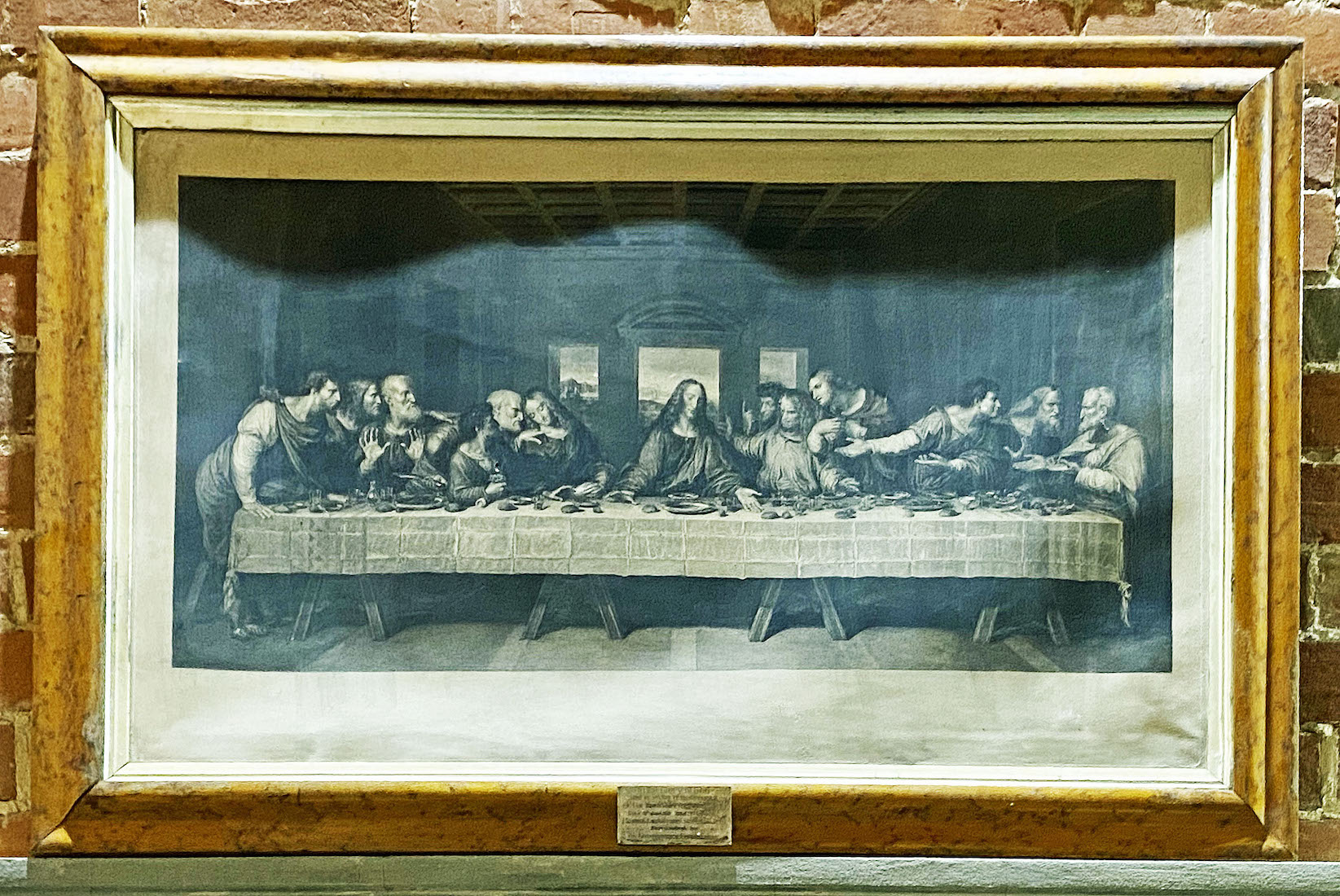
The Last Supper is a mural painting by the Italian High Renaissance artist Leonardo da Vinci, dated to c. 1495–1498. It is housed in the refectory of the Convent of Santa Maria delle Grazie in Milan, Italy. The painting represents the scene of the Last Supper of Jesus with the Twelve Apostles, as it is told in the Gospel of John – specifically the moment after Jesus announces that one of his apostles will betray him. Its handling of space, mastery of perspective, treatment of motion and complex display of human emotion has made it one of the Western world’s most recognizable paintings and among Leonardo’s most celebrated works.
69. ST MICHAEL AND JONATHAN
Above the South exit door is a window depicting the Archangel Michael, and next to this, a window picturing Jonathan. Both of these windows were created by Morris & Co. It must be said that the Jonathan window is remarkably similar to the St Paul window on the North wall – probably because both window designs were created by Edward Coley Burne-Jones (1833 – 1898).
70. SOUTH NAVE
Here are some direct views looking through the arches as we walk along the central aisle of the nave.
71. VALIANT FOR TRUTH, AND DAVID
The third and fourth windows along the North side are entitled Valiant for the Truth, and David. Both windows were created by R.S. Buxton & Co, Brisbane, with cartoons by William Bustard. The window at left is a memorial to all those who died in the Second World War. It is interesting in that the subject matter comes from ‘Pilgrim’s Progress’ by John Bunyan.
72. MEMORIAL STRIP AND TABLET
All along the central concrete banding strip around the nave is a strip of brass memorial plaques. These remember mainly people associated with the Church who have given special service. So we read here: ‘In loving memory of Miss K.H.J. (Hazel) FRITH (23.11.1907 – 1.12.99) Faithful parishioner all her life.’ •• The Valiant for Truth plaque shown at right picks up on the title of the nearby window, and lists the names of parishioners who died in World war II (1939 – 1945).
73. ITEMS ON THE SOUTH COLUMNS
These historic items are attached to the columns. •• An early grand design of All Souls, with clerestory windows and domes. •• A 1909 Church calendar, presented to the faithful by the Rector and Wardens. •• An early photo of clergy, servers, choir, ... ?
74. PHOTOS ON SOUTHWEST COLUMN
The Westernmost column on the South side has historic photographs on three sides. They show various happenings in the early life of All Souls’: Girls’ Friendly Society 1930; Day School 1930 or 1931; Redd Murphy with parishioners 1923; Garden Fete ca 1905.
75. A VIRTUOUS WOMAN
The final window on the South side shows a Virtuous Woman. ‘The text reads: Who can find a virtuous woman? for her price is above rubies.’ (Proverbs 31:10) This is another window by R.S. Exton & Co, Brisbane with cartoon by William Bustard, dating from 1950 and restored 1973.
76. FINAL VIEW OF THE SOUTH NAVE
We have now walked right around the inside of this lovely Church, and look back along the South nave.
77. GOODBYE!
A final view of the Church from the chancel. This completes our tour of All Souls’ Anglican Church.

CONCLUSION
I have lived near this Church for 57 years, and never explored it! It has been a real blessing for me doing this photographic tour, and I hope you have enjoyed it too.
I am happy to receive constructive comments or corrections concerning this website. The best websites are the ones which have no errors! I am grateful to my wife Margie who has proof-read these pages.
The Church has its own website with link
https://www.allsoulsstpeters.org.au
The photographs which appear on this site can also be found in higher resolution at:
https://www.flickr.com/photos/paulscottinfo/sets/
Site created 06 / 2024
Paul Scott




